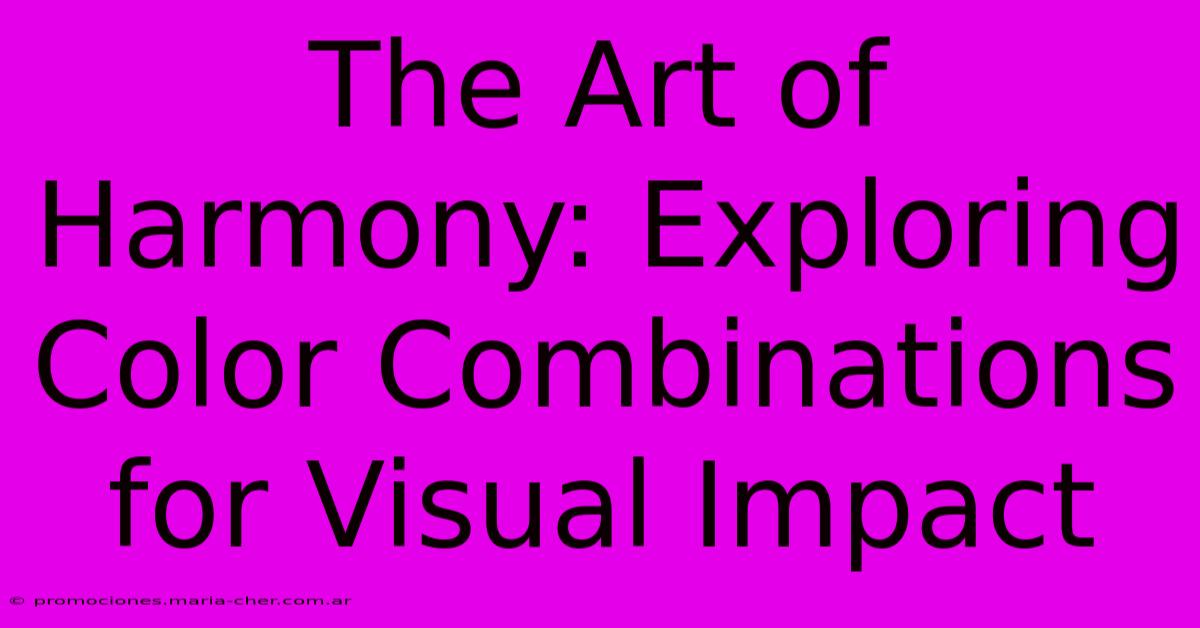The Art Of Harmony: Exploring Color Combinations For Visual Impact

Table of Contents
The Art of Harmony: Exploring Color Combinations for Visual Impact
Color. It's more than just a visual element; it's a powerful tool that evokes emotions, influences perceptions, and ultimately, dictates the success of any visual design. Mastering color combinations is crucial for creating visually stunning and impactful work, whether you're a graphic designer, painter, interior decorator, or simply someone who appreciates aesthetically pleasing visuals. This article delves into the art of color harmony, exploring various combinations and techniques to elevate your designs.
Understanding the Color Wheel: Your Guide to Harmony
The color wheel is the foundation of color theory. It's a circular arrangement of colors, typically showing primary (red, yellow, blue), secondary (green, orange, violet), and tertiary colors. Understanding its structure is key to selecting harmonious palettes.
Key Color Relationships for Striking Combinations:
-
Complementary Colors: These colors sit directly opposite each other on the color wheel (e.g., red and green, blue and orange). They create high contrast and visual excitement. Use them strategically, as they can be intense if overused. Consider using one color as a dominant shade and the other as an accent.
-
Analogous Colors: These are colors that sit next to each other on the color wheel (e.g., blue, blue-green, green). They create a sense of calm and harmony, often found in nature. This combination is versatile and easy on the eyes.
-
Triadic Colors: This involves three colors evenly spaced on the color wheel (e.g., red, yellow, blue). They offer a vibrant and balanced palette, though careful consideration of value and saturation is needed to avoid visual clash.
-
Tetradic Colors: Also known as double complementary, this scheme uses two sets of complementary colors (e.g., red-orange and blue-green, yellow-orange and blue-violet). It's a complex combination that can be challenging but offers rich visual depth when executed well.
Beyond Basic Combinations: Adding Nuance and Depth
While understanding basic color relationships is essential, achieving true visual mastery requires exploring nuances within color harmony.
Exploring Value, Saturation, and Temperature:
-
Value: This refers to the lightness or darkness of a color. Varying the value of colors within your chosen scheme adds depth and dimension.
-
Saturation: This refers to the intensity or purity of a color. Desaturated colors (muted tones) create a softer, more subtle feel, while highly saturated colors are bold and vibrant.
-
Temperature: Colors can be perceived as warm (reds, oranges, yellows) or cool (blues, greens, purples). Balancing warm and cool tones within a palette adds visual interest and can evoke specific moods.
Practical Applications: Putting Color Harmony into Action
The principles of color harmony are applicable across various design disciplines.
Examples in Different Fields:
-
Graphic Design: Think of a website's color scheme, a company logo, or a brochure design. Harmonious color choices enhance brand identity and visual appeal.
-
Interior Design: Color plays a crucial role in setting the mood and atmosphere of a space. A calming bedroom might use analogous colors, while a vibrant kitchen might utilize a triadic scheme.
-
Fashion Design: Color combinations in clothing create distinct styles and personal expressions. Understanding color harmony helps designers create visually appealing and cohesive outfits.
-
Fine Art: Painters have used color harmony for centuries to create masterpieces, evoking emotions and telling stories through carefully chosen palettes.
Mastering Color Harmony: A Continuous Journey
The art of color harmony is a continuous learning process. Experimentation is key! Don't be afraid to try different combinations, explore different software tools and resources, and analyze the color palettes of works you admire. By understanding the fundamental principles and applying them creatively, you can unlock the power of color to create truly impactful visual experiences. Remember, the best color combinations are those that resonate with your personal vision and achieve the desired effect.

Thank you for visiting our website wich cover about The Art Of Harmony: Exploring Color Combinations For Visual Impact. We hope the information provided has been useful to you. Feel free to contact us if you have any questions or need further assistance. See you next time and dont miss to bookmark.
Featured Posts
-
Unleash Your Aussie Brain Power The Ultimate Guide To Thinking Fast And Slow
Feb 09, 2025
-
The Power Of Contrast Creating Visual Interest Through Color
Feb 09, 2025
-
Elevate Your Emails The Art Of Selecting Signature Quotes For Maximum Impact
Feb 09, 2025
-
The Sparkling Elixir Unveiling The Secrets Of Champagne And Champaign
Feb 09, 2025
-
Paint Your World With Hues Of January Uncover The Vibrant Color Thats Perfect For You
Feb 09, 2025
